
"On August 22, President Donald Trump announced via Truth Social that the U.S. federal government had acquired 10% of Intel. The chipmaker's news release trumpeted the deal as "historic." That it was. But it was also ignominious. In Trump's own account, he had humbled an iconic American company. Maybe even shaken it down. Fifteen days earlier, he posted to Truth Social that Intel CEO Lip-Bu Tan had ties to China, which left him "highly CONFLICTED" and demanded his immediate resignation. On August 11, Tan visited the White House. On August 22, the deal was official."
"For anyone who lived through the PC's heyday in the 1990s, seeing Intel run out of options is a stunning development. It's not just that it dominated the market for PC processors so utterly that after years of shrinkage it still has close to a 75% share. More than any other company, Intel once shaped the technologies that kept the technology business booming. In a sense, the entire PC industry became a front for it, to a degree that wasn't obvious then and has since fad"
On August 22, the U.S. federal government converted previously approved CHIPS Act support into a 10% ownership stake in Intel rather than providing new funding. The stake served as a retroactive quid pro quo for $8.9 billion that Intel had been granted but not yet received under the CHIPS and Science Act. The transaction followed public pressure from President Donald Trump, who questioned Intel CEO Lip-Bu Tan's ties to China and demanded his resignation. Taiwan's TSMC resisted U.S. demands for equity even at the risk of losing CHIPS funding. Intel remains a dominant PC-processor company with historic influence over the industry.
Read at Fast Company
Unable to calculate read time
Collection
[
|
...
]